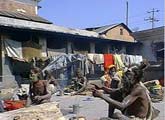|
Hinduism's routes go
back over 2000 years to the time when the Aryan invaders
met India's Indus Valley civilization. Belief in natural
forces, fertility and mother goddesses joined the caste
system and the sacred book of the Vedas to form the
foundation of Hindu beliefs, as much a social system as
a religion. It is based around a trinity of three
Gods, Brahma (the Creator), Vishnu (the Preserver) and
Shiva (the Destroyer). Although Hindus in Nepal may pay
equal respect to all three gods as part of their
religion, some may confess to follow either Vishnu or
Shiva. There are four main castes in Nepal which are
practiced as part of the Hindu religion, the Brahmans
(priest caste), the Kshatriya (warriors), the Vaisyas
(merchants) and finally the Sudras (menial workers).
The ultimate goal for Hindus is to break the cycle of endless
rebirths. Though working towards that worship can
improve one’s condition in this life and in subsequent
rebirth. The ultimate source of creation is the supreme
and formless Brahman who manifests in infinite forms.
The three main aspects, depicting three main forces of
the universe, are Brahma the creator, Vishnu the
preserver and Shiva the transformer and destroyer. Each
of these has innumerable manifestations; there are as
many gods as there are facets of human nature, which is,
in fact, what they represent.
Hinduism in Nepal
Hinduism is the major religion of Nepal. In the 1991 census,
approximately 89.5 percent of the Nepalese people
identified themselves as Hindus. Buddhists and Muslims
comprised 5.3 and 2.7 percent, respectively. The
remainder followed other religions, including
Christianity. The national calendar of Nepal, Bikram
Sambat (B.S.), is a solar Hindu calendar essentially the
same to that widespread in North India as a religious
calendar, and is based on Vedic principles of
time-keeping. The geographical distribution of religious
groups revealed a majority of Hindus, accounting for at
least 87 percent of the population in every region.
Among the Tibeto-Nepalese, those most influenced by
Hinduism were the Magar, Sunwar, and Rai peoples.
Copyright Source :-
https://www.myholidaynepal.com/hinduism.html
|
|
Hindu beliefs and practices
Categorizing the religion of Hinduism is somewhat
confusing:
Hinduism has commonly been viewed in the west as a
polytheistic religion - one which worships multiple
deities: gods and goddesses. Some have viewed it as a
monotheistic religion, because it recognizes only one
supreme God: the panentheistic principle of Brahman,
that all reality is a unity. The entire universe is seen
as one divine entity who is simultaneously at one with
the universe and who transcends it as well.
Some view Hinduism as Trinitarian because Brahman is
simultaneously visualized as a triad:
|
Brahma the Creator who is
continuing to create new
realities |
|
Vishnu, (Krishna) the Preserver,
who preserves these new
creations. Whenever dharma
(eternal order, righteousness,
religion, law and duty) is
threatened, Vishnu travels from
heaven to earth in one of ten
incarnations. |
|
Shiva, the Destroyer, is at
times coMapssionate, erotic and
destructive. |
|
 |
|
Shiva |
|
|
Strictly speaking, Hinduism is a henotheistic religion -
a religion which recognizes a single deity, but which
recognizes other gods and goddesses as facets or
manifestations or aspects of that supreme God.
Most urban Hindus follow one of two major divisions
within Hinduism:
|
Vaishnavaism: which generally regards
Vishnu as the ultimate deity |
|
Shivaism: which generally regards Shiva
as the ultimate deity. |
|
 |
Many rural Hindus
worship their own village goddess or an
earth goddess. She is believed to rule
over fertility and disease - and thus
over life and death. The priesthood is
less important in rural Hinduism:
non-Brahmins and non-priests often carry
out ritual and prayer there.
Hindus believe in the repetitious
Transmigration of the Soul. This is the
transfer of one's soul after death into
another body. This produces a continuing
cycle of birth, life, death and rebirth
through their many lifetimes. |
|
It is called samsara. Karma is the accumulated sum of
ones good and bad deeds. Karma determines how you will
live your next life. Through pure acts, thoughts and
devotion, one can be reborn at a higher level.
Eventually, one can escape samsara and achieve
enlightenment.
Bad deeds can cause a person to be reborn as a lower
level, or even as an animal. The unequal distribution of
wealth, prestige, suffering are thus seen as natural
consequences for one's previous acts, both in this life
and in previous lives.
Hindus organize their lives around certain activities or
"purusharthas." These are called the "four aims of
Hinduism," or "the doctrine of the fourfold end of
life."
|

